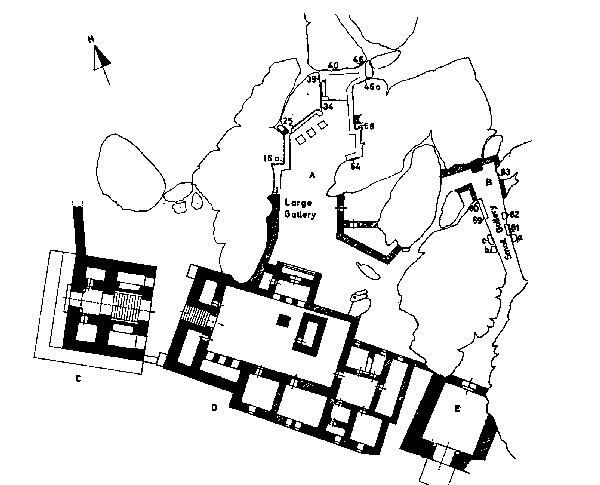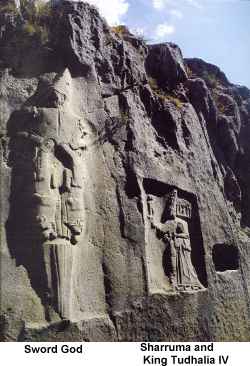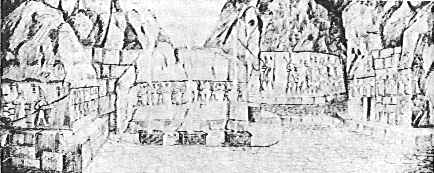YAZILIKAYA
The national sanctuary of the Hittite Empire, today called Yazılıkaya, lies 2 km.
north-east of Hattusa (Boğazköy). It was a natural rock shrine, open to the sky. The
temple buildings later erected in front of this cult area display remains of three
different periods. The accompanying ground plan of Yazılıkaya,
however, shows only the second phase of the temple. Nevertheless, an examination of the
ruins on the spot reveals that at the lowest level was a simple enclosing wall, which
separated the rock shrine from the outside world in the first period. In the second phase
a temple was built in the canonical type of Hittite sanctuaries (plan of
Yazılıkaya) developed in Hattusa (plan of temples).
A gatehouse (plan of Yazılıkaya C) was constructed at this time,
similar to the gateway in the Great Temple at Hattusa (plan
of temples), which served as a monumental entrance to the sanctuary. During the same
phase, a gateway was erected in front of the small gallery (plan of
Yazılıkaya E). In the third period, the east wing of the main building was altered to accommodate the
construction of a more appropriate entrance in front of the small gallery. The temple of
the second phase, like the sanctuaries at Hattusa, consisted of rooms surrounding a
courtyard with a lustral chamber and a pillared hall giving access to the cult room (plan of Yazılıkaya). However, religious ceremonies, which in the temple
of Hattusa took place in closed rooms before the statue of the Storm God, were performed
in the rock gallery in the open air, below reliefs representing almost the entire Hittite
pantheon.

Plan of Yazılıkaya.
- Great Rock-Gallery adorned with reliefs representing 63 Hittite divinities. Probably
erected by Hattusiti III (1275-1250 B. C.).
- Small Rock-Gallery, a mortuary temple reserved for the royal cult. Probably erected by
Tudhaliya IV (1250-1220 B. C.).
- Monumental Gateway leading to the temple (D), erected by Hattusili III.
- Main building of the temple. Probably erected by Hattusiti III (see p. 262).
- Entrance giving access to the small gallery. Possibly it was erected by Tudholiya IV.
A third open-air chamber, connected with the Small Gallery and marked C (not shown on
our plan), was excavated last year. The function of this room, which has no reliefs, is
not known yet.
The west wall in the large gallery is adorned with reliefs of gods (Nos. 1-39), while those on
the east wall are devoted to goddesses (Nos. 43-63). Both rows meet at the junction of
these walls with the north wall (Nos.
40-46 and main scene). The division into
male and female deities is not absolute; three goddesses can be discerned among the gods
(see relief of gods, Nos. 36-38; Ishtar), and one god is noticeable in the
row of females (No. 44). The central scene on the north wall depicts the chief divinities.
A place of particular significance has been allotted to the relief of King Tudhaliya IV
(1250-1220 B. C.). It is the largest relief in the gallery (plan of
Yazılıkaya, No. 64; portray of Tudhaliya), being 2.95 meter in
height, one third more than that of the main scene, which is only 2.18 m. high. We may
assume that Tudhaliya had his picture carved on the east wall overlooking the main scene
because he was personally interested in the completion of the sanctuary. This was
originally erected by his father Hattusili III (1275-1250
B. C.), in collaboration with Puduhepa, his ambitious
mother. No doubt Puduhepa, who was a powerful queen and afterwards reigned with her son
Tudhaliya IV, played an important part in the construction of this sanctuary. As Emmanuel
Laroche has recognized, this contained, a magnificent representation of the Hittite
pantheon, arranged according to the ceremonial order of the Hurrian religion. She was a
princess of Kummanni in Kizzuwatna, one of the chief cult centres of the goddess Hepatu,
who is depicted in the main scene at the
sanctuary (No. 43). Her very name betrays that she was a devotee of Hepatu. The Egyptian
version of the treaty between Hattusili III and Rameses II describes the royal seal
appearing on the Hittite silver tablet as showing the queen in the embrace of the Sun
Goddess of Arinna, the Hittite counterpart of the Hurrian Hepatu. On the whole, however,
the divinities were represented in their Anatolian Hittite character. Although the
composition of the reliefs follows the ceremonial order observed in the Hurrian religion,
the deities themselves are depicted entirely according to Hittite iconographic principles.
A beholder from Hattusa would only see representations of Hittite deities before him. The
artistic style of the reliefs is also wholly Hittite in character.
The small gallery, which was approached by a separate entrance (plan of
Yazılıkaya), also contains a number of relief sculptures in a good state of
preservation. Kurt Bittel and his colleagues, the excavators of Yazılıkaya, are of the
opinion that this small gallery was dedicated to the cult of a dead king, either Tudhaliya
II or III. Although this clever interpretation is in complete agreement with written
sources and with the non-oriental character of the Hittite culture and religion, it would
seem that this gallery was nevertheless reserved for the apotheosis of King Tudhaliya IV
in his lifetime; for there are two portrayals of the monarch in the small gallery as well
as the large relief in the main one. Apart from the magnificent relief sculpture in the
small gallery showing the king in the  embrace of the god Sharruma, there was also a statue of him
which is now lost, though its statue-base and cartouche on the wall still exist (plan of Yazılıkaya, No. 83). It is significant that not only is the
entrance directly opposite the statue-base, but, in addition, all the figures in the
gallery are turned towards it (reliefs of Sharruma,
the twelf gods, sword god). Bearing in mind that the king
was represented three times and that his reliefs and statue occupied the most important
position in both galleries and, further, that he was depicted to the exclusion of all
other rulers, one is inclined to assert that these images were made during his lifetime.
On the other hand, none of these portrayals can have represented Tudhaliya III, who
reigned from 1400 to 1380 BC, Reliefs which reflect such a marked Hurrian influence and
display such iconographical uniformity could only have been realised in the time of
Puduhepa, the daughter of the high priest from the Hurrian country of Kizzuwatna. She had
clay tablets from Kizzuwatna copied for the Hisuwa festivals. Consequently, Tudhaliya IV
was introduced to the Hurrian religion in his mother's house. Thus he reorganised the
Hittite state cult according to Hurrian rites. The stylistic differences between the three
cartouches may have no chronological importance as they were probably carved by different
sculptors or at different periods during the monarch's life. We, therefore, believe that
the temple of the second phase, together with the reliefs of divinities in the large
gallery, was built in the reign of Hattusili III (1275-1250 B. C.), and the relief
of Tudhaliya, the small gallery and the third phase of the temple were achievements of
Tudhaliya IV (1250-1220 B. C.). The possibility that his son Arnuwanda IV (1220-1190 B.
C.) could have erected the sanctuary is out of the question, for his reign fell in so
troubled a period that he could hardly have been in a position to make artistic and
religious undertakings of such magnitude. embrace of the god Sharruma, there was also a statue of him
which is now lost, though its statue-base and cartouche on the wall still exist (plan of Yazılıkaya, No. 83). It is significant that not only is the
entrance directly opposite the statue-base, but, in addition, all the figures in the
gallery are turned towards it (reliefs of Sharruma,
the twelf gods, sword god). Bearing in mind that the king
was represented three times and that his reliefs and statue occupied the most important
position in both galleries and, further, that he was depicted to the exclusion of all
other rulers, one is inclined to assert that these images were made during his lifetime.
On the other hand, none of these portrayals can have represented Tudhaliya III, who
reigned from 1400 to 1380 BC, Reliefs which reflect such a marked Hurrian influence and
display such iconographical uniformity could only have been realised in the time of
Puduhepa, the daughter of the high priest from the Hurrian country of Kizzuwatna. She had
clay tablets from Kizzuwatna copied for the Hisuwa festivals. Consequently, Tudhaliya IV
was introduced to the Hurrian religion in his mother's house. Thus he reorganised the
Hittite state cult according to Hurrian rites. The stylistic differences between the three
cartouches may have no chronological importance as they were probably carved by different
sculptors or at different periods during the monarch's life. We, therefore, believe that
the temple of the second phase, together with the reliefs of divinities in the large
gallery, was built in the reign of Hattusili III (1275-1250 B. C.), and the relief
of Tudhaliya, the small gallery and the third phase of the temple were achievements of
Tudhaliya IV (1250-1220 B. C.). The possibility that his son Arnuwanda IV (1220-1190 B.
C.) could have erected the sanctuary is out of the question, for his reign fell in so
troubled a period that he could hardly have been in a position to make artistic and
religious undertakings of such magnitude.
The three rectangular niches in the small gallery may have contained the burial urns of
the Hittite royal family, beginning with Hattusili III and his wife Puduhepa.
 Rock sanctuary at
Yazılıkaya. General view of the great gallery. The reliefs, which consist of 64
figures and represent 63 deities of the Hittite pantheon, were carved in the reign of
Hattusiti III (1275-1250 BC). Rock sanctuary at
Yazılıkaya. General view of the great gallery. The reliefs, which consist of 64
figures and represent 63 deities of the Hittite pantheon, were carved in the reign of
Hattusiti III (1275-1250 BC).
|